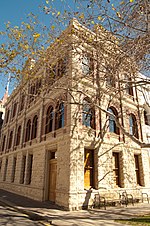Fremantle Harbour

Fremantle Harbour is Western Australia's largest and busiest general cargo port and an important historical site. The inner harbour handles a large volume of sea containers, vehicle imports and livestock exports, cruise shipping and naval visits, and operates 24 hours a day. It is located adjacent to the city of Fremantle, in the Perth metropolitan region. Fremantle Harbour consists of the Inner Harbour, which is situated on the mouth of the Swan River; the Outer Harbour, which is 20 km (12 mi) south at Kwinana in Cockburn Sound and handles bulk cargo ports, grain, petroleum, liquefied petroleum gas, alumina, mineral sands, fertilisers, sulphur and other bulk commodities; and Gage Roads, which is the anchorage between Rottnest Island and the mainland. The Inner Harbour includes northern and southern wharves named North Quay and Victoria Quay respectively. All of this area is managed by the Fremantle Port Authority, a government trading enterprise, under the registered business name Fremantle Ports.
Excerpt from the Wikipedia article Fremantle Harbour (License: CC BY-SA 3.0, Authors, Images).Fremantle Harbour
Rous Head Road,
Geographical coordinates (GPS) Address Nearby Places Show on map
Geographical coordinates (GPS)
| Latitude | Longitude |
|---|---|
| N -32.05 ° | E 115.73333333333 ° |
Address
Rous Head Road
Rous Head Road
6959 , North Fremantle
Western Australia, Australia
Open on Google Maps










